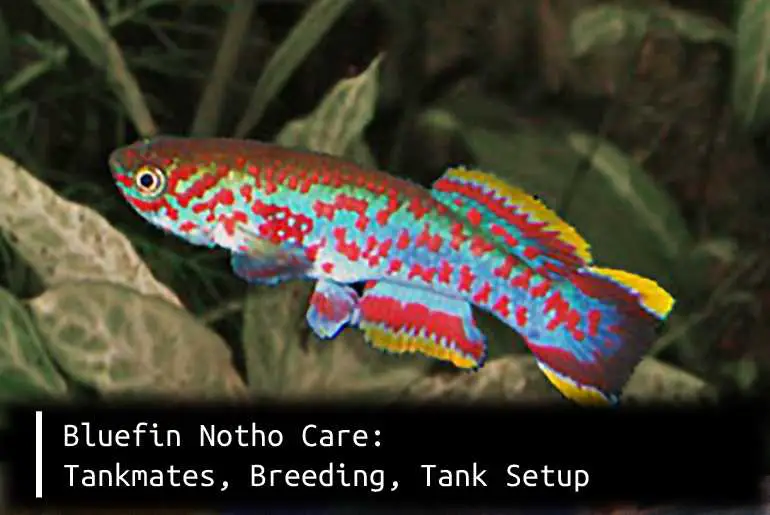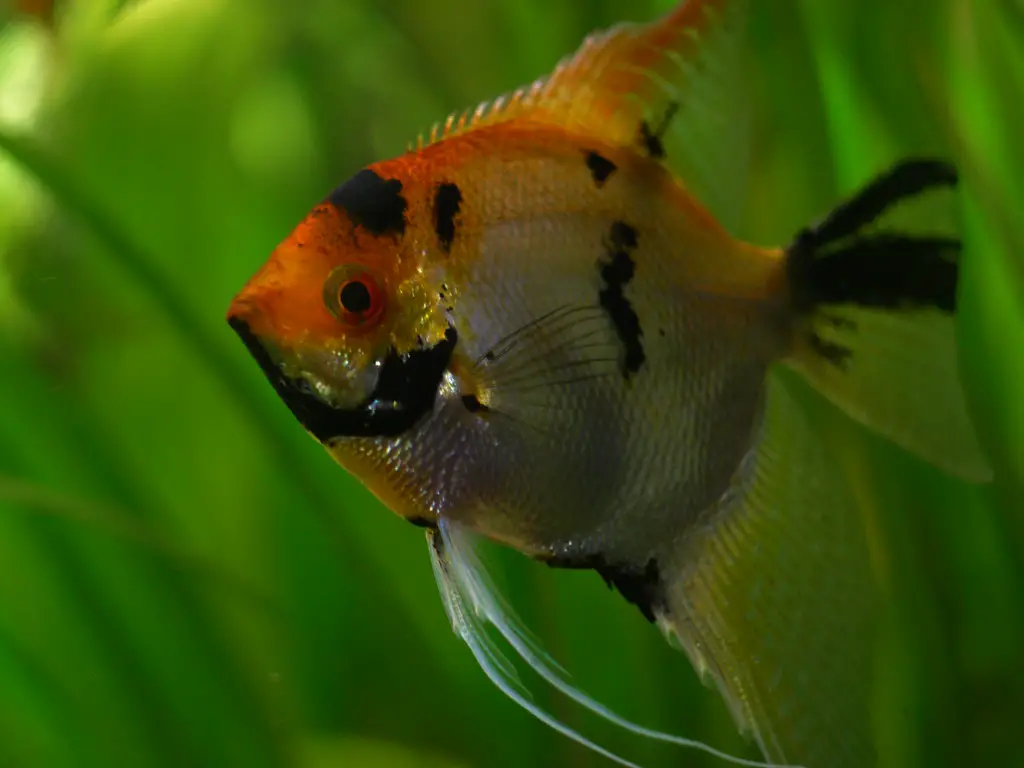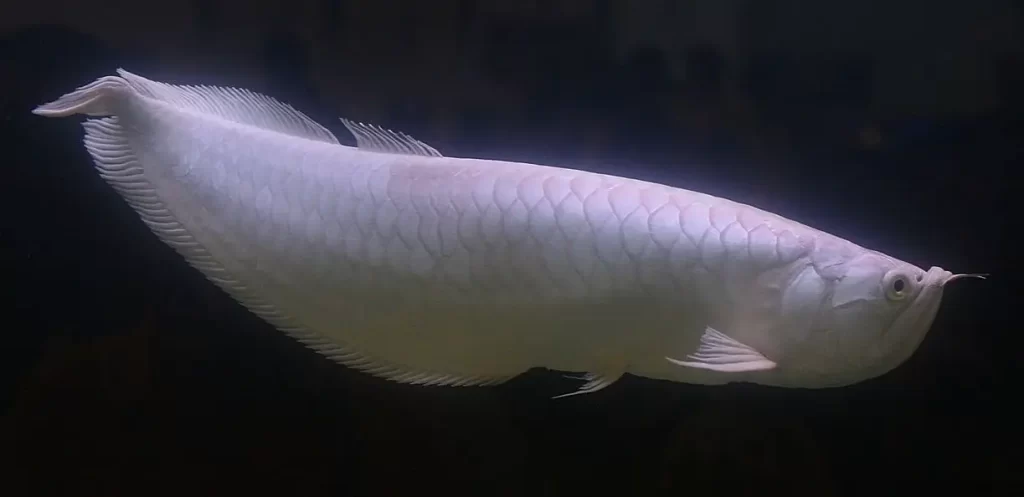Looking for fish to brighten up your aquarium? The vivid color of the Bluefin Notho will shine through in your aquarium. Bluefin Notho is one of the species with the brightest colors to add to a species aquarium. This fish will add life and color to the aquarium, but it should be kept in a breeding tank specifically for its species, with at least two females for every male. These fish are very petite fish that can grow up to 6 cm.
Bluefin Notho is popular with those who like raising killifish from eggs in aquariums. Only species tanks should be used to house these fish. Males may be rather violent with one another, so if you plan to keep two, your tank has to be quite significant. These fish are not very picky eaters so these fish will consume most items like white worms, brine shrimp, dry flakes, and much more. This Killifish can adapt to a wide range of water conditions and is not demanding. This species mostly has blue and orange fish. This fish is perfect for beginners, and we have got everything you need to know about this fish.
So read more if you want to know more about Bluefin Notho.
Origin And Habitat Of Bluefin Notho
Bluefin Notho is from both the Pungwe River and the Zambezi River. Geographically, the Kwa Kwa River and Beira in Mozambique both have access to fish. Many people believe that because of their varied topographies, these fish have a wide range of colors, with some fish being darker and others having the same tints in lighter homes.
Lowland water areas like ponds and marshes make up the Bluefin Notho’s habitat. During the summer, the water frequently dries up, but when rain falls, it replenishes itself. Even in areas with little water, the tiny fish can be detected on semi-deep animal footprints.
Lifespan
Since these fish only have one year to live, they are frequently referred to as the yearly Killifish. It is their average life span, and no single instance of a particular species having lived extraordinarily long has been documented.
Bluefin Notho can only live for one year. Hence the conditions must be favorable for its cyclical mating, or it will go extinct in that area. When the right time for breeding arrives, these fish can develop swiftly.
For more details about lifespan, you can check out our article about killifish lifespan.
Appearance
Depending on your point of view, the male’s reflecting body and vibrant iridescent colorations allow you to see them in varying shades of blue.
The duller brown with a yellowish tint and transparent fins distinguish the females from the males. Males may easily be distinguished from females since these fish have the same pigmentation on their bodies and fins.
Dual hues of orange and red serve as the base or main body color and are presented as a cluster of colors in Bluefin Notho. The entire body is covered in dazzling blue hues in slim designs that start off little but become larger towards the tail and fins. The fish have vivid blue and orange colors on their ray fins.
Size
Fish raised in tanks versus those raised in the wild differ in size. This is because the fish’s size is influenced by the aquarium’s water quality. The size of the wild ones is about 2.4 inches. The ones that are grown in tanks are only up to 1.9 inches long. Fish males are larger than female Bluefin Notho.
There are more details about the size and factors affecting its growth. Check out our article on Bluefin Notho size.
Behavior & Temperament
This calm killifish can dwell in a communal tank with other species of a similar size. Bluefin Nothoo do best when housed with other animals that have comparable habitats and water requirements. As these fish could live shorter lives than their tank mates, the fish are quite active in the tank.
It’s crucial to understand how these fish behave when they’re about to spawn. You don’t want to miss the crucial moment in their life cycle because if you do, all the fish in your tank will be dead. The vivid look and generally good conduct of Nothobranchius rachovii make it a desirable alternative for community or species aquariums.
Tank Requirements for Bluefin Notho
There is nothing that the Bluefin Notho needs that you can’t easily provide. Here, we discuss a few easy water characteristics that are beneficial for the species’ development and survival. You may find tips on this page on how to set up the Notho Fish’s aquarium.
Tank Size
Even if a single fish can easily fit in a 5-gallon tank, we never advise it and don’t support the fact that it can. This is for several reasons, not the least of which is that no fish should ever be allowed to survive on the barest necessities.
Second, although the fish may be swimming freely inside the tank, it must remain by itself because adding more fish would make the nano tank crowded and awkward. As a result, it is usually preferable to keep a large tank, not an enormous one, but one that is at least 10-15 gallons in capacity.
Because this fish belongs to a community, you must leave some extra room for other fish. No fish should be permitted to experience the stress that comes with the confined space, regardless of species.
Firstly, when I put a killifish aquarium, I was confused about the ratio. Here is an article about how man killifish you can keep in a 10-gallon or 20-gallon tank to help you with the same issue.
Tank Lid
Because fish can jump out of tanks on instinct to move to nearby water bodies, the lid is crucial. Because these fish must move to better locations in nature where these fish may find enough water, this is a natural propensity. Perhaps, for this reason, you should always make sure that a lid is adjusted correctly.
Make sure, on your end, that there is sufficient space between the lid and the higher level of the tank’s water because a jumping fish could damage itself against the cover.
Filter
The tank should contain a filter to remove all the decaying food fragments and any other unclean materials. It should be emphasized that the filter should keep the water moving at a pace that is virtually as excellent as a still or barely moving body of water.
The fish may suffer if the filter is unable to achieve this and creates excessive flow since these fish will have to adjust to the water’s speed by venturing outside of their comfort zone.
Do Killifish need a filter and aeration? If such questions arise in your mind, too, here is the answer.
You can choose the Air-driven Sponge Filter because it can serve the dual goals of purifying water and preserving water flow with sufficient effectiveness.
Lighting
Nothobranchius rachovii prefers lower light temperatures of about 4500K when it comes to lighting. The Nothobranchius rachovii can exhibit leaping fits when exposed to high-temperature direct lighting in the tank, which replicates the sun at its zenith.
The Nothobranchius rachoviis’ inclination in an aquarium is to leap and flee in search of another water pool before its present one (your tank) dries out. Nothobranchius rachovii may wind up hurting itself on the tank lid or land on your home’s floor in a fatal posture.
Substrate
Peat or material comparable to it that can create a black appearance should be used to cover the substrate.
Temperature
Nothobranchius rachovii must adapt to rapid changes in temperature during the day that ranges from 16 to 32 degrees Celsius in their natural environment.
Maintain Rachovii in the aquarium at a consistent 23 degrees Celsius, which is a touch lower than the average community tank. This makes sense because Nothobranchius is an annual species, which means that warmer temperatures speed up their growth and reduce their longevity.
The goal of keeping Nothobranchius rachovii in water cooler than 20 degrees celsius is defeated since the males lose their color.
Decor
To ensure that the fish have no problems, the tank should be decorated carefully. Include elements that can contribute to the creation of the dark substrate, such as bogwood, pebbles, and leaf litter. It’s possible that some aquatic decorations, such as roots, are providing fish with places to hide.
The more plants there are, the more likely the lights will fall into a smoother zone since the aquatic plants’ leaves and stems will reduce light intensity. For keeping the tank densely planted, Dwarf Sagittaria, Java Fern, Java Moss, Cabomba, and Ludwigia are suitable options. You can also keep roots in dense arrangements to produce the darkness the fish need to survive.
| Image | Plants for tetra aquarium | Link |
 |
Java Moss | |
 |
Amazon Sword | |
 |
Hornwort | |
 |
Java Fern | |
 |
Anubias Petite |
Water Type
The Bluefin Notho prefers warm temperatures, to the point where the water frequently threatens to dry up. However, the fish also experiences frequent temperature drops. You must make sure that your fish receives everything that could acclimate them as the owner or aquarist.
PH Level
Nothobranchius rachovii can tolerate water with a pH of 6.0 to 7.0 and a hardness of between 5 and 20 dGH. They like slightly acidic water. Aquarium botanicals or natural goods like Castle Dawn Aquatics Aquarium Peat Filter Media “TURF” can be used to do this with ease.
When it comes to water conditions, the species is not particularly difficult, and among all the old-world killifish, they can handle most rookie errors. Avoid adding CO2, which can cause the pH to drop to harmful levels, if you want to maintain the species at their ideal pH of around 6.0.
Tank Mates For Bluefin Notho
The ideal aquarium for Bluefin Notho has one male and three to five females. The presence of numerous males might lead to conflicts between the males as they vie for the female’s attention. The conflicts between the males usually conclude with a wounded ego and a few nipped fins and are not particularly harmful.
Keep Nothobranchius rachovii with other Killifish species, such as Aphyosemion striatum or austral, if you’re keeping them in a communal tank. Corydoras and dwarf gouramis, like the Honey gourami, all make good tank companions.
Diet
Since the fish can eat both live and frozen items, feeding them is not an issue, even though they are a carnivorous species. The fish has a small mouth and a good metabolism rate, which the aquarists need to keep in mind.
Continue reading to find out what they eat daily. The fact that they can eat as much as you can give them because they can digest food properly makes this combination seem strange, yet it can be difficult to sustain.
Due to their small jaws, they are more likely to choke on food. To feed them, you must do so frequently, preferably 2-3 times daily, and in modest amounts. In this manner, you can fulfill their need without endangering their lives.
We advise live foods because they are higher in protein and contain all the nutrients required for optimal growth. Brine shrimp, daphnia, mosquito larvae, grindal worms, cyclops, and white worms. While flakes are also beneficial, live feeds are best for this energetic fish.
I generally use the following brands for my Bluefin Notho. You can definitely check these out if you are looking for some options:
- Omega one pellets
- Ocean Nutrition Instant Baby Brine Shrimp 0.7-Ounces (20 Grams) Jar
- Omega One Freeze-Dried Blood Worms, 0.96 oz
- Hikari Bio-Pure Freeze Dried Daphnia for Pets, 0.42-Ounce
Breeding
Here is a step-by-step guide for breeding Bluefin Notho.
Setup and Mating
Place a male and at least three female Nothobranchius rachovii in a 5-gallon aquarium with a 2-inch-deep peat substrate container to breed the species. A flashy display by the male will entice the ladies, who will then dive into the peat substrate with the male and lay their fertilized eggs there.
Over a few minutes, the Nothobranchius rachovii pair will repeat the operation, resulting in multiple batches of eggs hidden within the peat substrate. Take out the peat from the aquarium and let it air dry until it is only slightly damp. Place the peat and eggs in an airtight bag or container, keeping it damp throughout, and store it for up to three months in a secure location.
Put the peat/eggs in old water when the three months are up. The anaerobic conditions will induce the fry to hatch in about ten days. The fry should be taken out and put in a rearing tank with lots of plants and soft, acidic water. The peat/eggs can be removed, dried again for a further week, and then the procedure of immersing it in the water is repeated. This will allow any stragglers that did not hatch the first time to hatch.
Fry Care
Nothobranchius rachovii fry will start eating newly hatched brine shrimp right away and will continue to do so as they grow. At 1.5 months, males and females are easily distinguished.
It’s critical to remove any uneaten food and maintain the water’s quality. This is because fry might be vulnerable to fungus and changes in water parameters.
Furthermore, what can you feed killifish fry? Find out here!
To avoid any significant changes in the water chemistry that could cause the death of all the fry, perform minor, frequent water changes rather than massive ones once a week.
Diseases And Prevention For Bluefin
Giving the fish the wrong foods, especially in huge quantities, might cause it to get very unwell. They may experience severe stomach issues. Other major problems include ammonia poisoning, mouth fungus, fish fungus, fish lice, swim bladder illnesses, fin rotting, dropsy (stomach inflammation), and many others.
There are a lot of precautions you need to take. The fish will be able to live a healthy life as a result. This entails thorough tank cleaning, and the food must be clean and devoid of any kind of parasites. To keep your fish healthy, you simply need to provide the bare minimum of care.
For more details on Bluefin Notho disease symptoms, treatment, and cure, you can check out the link!
Frequently Asked Questions
How Long Do Bluefin Notho Live?
Bluefin Nothos are termed “annual” killifish because they reach maturity in approximately twelve weeks. These fish live for up to a year or a year and a half and then perish after the breeding season.
How Long Does It Take For Killifish Eggs To Hatch?
You must keep the bottom-spawner eggs in only damp peat for around three months (depending on the species). You should do this before water is given back to the tank, in contrast to the egg-hanger eggs, which hatch in about three weeks.
How Do You Spawn A Killifish?
Wild plant reproduction Killifish will lay their eggs near the water’s surface, either in clumps of bushy plants or among the roots of floating plants. As a result, you should give your fish identical spawning locations in the tank.
Conclusion
The tiny but magnificent fish comes in a lovely blend of many colors. Those contrast and complement each other nicely. The fish have a good nature and are simple to handle. If you’re a first-time owner, you shouldn’t worry about their requirements because all they need is a portion of basic carnivorous food and access to water.
This fish is perfect to light your tank up. Now that we have given you everything you need to know about this fish, you are ready to go and get your own Bluefin Notho friend.






